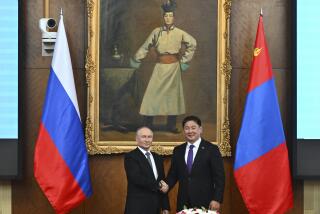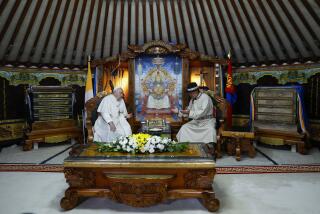Mongolia Battles for Economic Survival
- Share via
ULAN BATOR, Mongolia — Seven centuries ago, the Mongolian hordes of Genghis Khan savagely conquered a big chunk of the world.
Today, out of sight of most of the world’s press and low on the priority list of most other countries, Mongolia struggles to catch up with the 20th Century.
After seven decades of taking orders from Moscow, Mongolia’s 2.2 million people, wedged between Russia and China in a rugged and exotic country, are rediscovering their heritage--and battling for economic survival.
In 1921, four years after the Russian Revolution, Mongolia became the second country in the world to adopt communism. In 1990, it was the first Asian country to reject it.
The pro-democracy protest in this Russian-dominated capital began in December, 1989. In March, 1990, 4,000 demonstrators gathered in Sukhe Bator Square and staged a brief hunger strike.
Government troops, although based only minutes away, were not summoned, and within days a new government was in power, with a professed aim of building “democratic humane socialism.”
Now, Mongolia remains determined to make the transition from communism to capitalism. But the change to a market economy is proving difficult as the nation settles in for a long, cold winter marked by rising prices, increasing shortages and mounting protests against government policies.
Western countries and multinational organizations have pledged $243 million in grants and low-interest loans.
“A lot of it’s going to be used just to feed and heat the cities,” Peter Murrell, a University of Maryland economist who last visited Mongolia in October, said.
Mongolia does not have hard currency to buy fuel, spare parts, machinery and food, and its economy, once almost totally integrated with that of Russia, has been devastated. Aid from Moscow provided nearly one-third of the budget. Most trade was barter with the former Soviet Union and the communist countries of Eastern Europe for staples and technical assistance.
Mongolia’s short growing season and severe climate make it difficult to raise many crops. In the cities of a country where livestock vastly outnumber people, there is a shortage of meat, and many other foods are rationed. Milk is scarce. In the countryside, food is plentiful. But faced with almost valueless currency, farmers refuse to sell food to hungry townspeople.
Hospitals have run out of drugs. Shoes and boots are in short supply.
As tumultuous as the future might be in this aged land of horsemen and herdsmen, Mongolians are no strangers to tumult. The hard part may be getting accustomed to the inevitable outsiders as the secluded nation opens up.
For nearly 50 of the last 70 years, Mongolians have lived in almost total isolation, with only Soviet and Eastern European scientists, construction workers and military personnel visiting or working in the country.
Decades ago, Mongolia severed its relations with China, the giant to the south. “I would predict that there would be a huge role for China in Mongolia in the future,” Murrell said.
In the early 1960s, after becoming a member of the United Nations, Mongolia relaxed visiting restrictions a bit; a handful of hardy Western tourists and hunters traveled to a few towns and cities.
Under the communists, Genghis Khan was barely mentioned. Today, he is emerging as a hero. A new vodka and a hotel now under construction are named after him. His portrait is on a postage stamp.
In 1921, there were 800 Buddhist monasteries and 100,000 monks in Mongolia. Under communism, Buddhists were persecuted, and thousands of lamas and monks were killed.
Currently, only one monastery, Gandan in Ulan Bator, remains, with about 110 aged monks. But young monks are now in training, and the people feel freer to practice their religion.
In 1921, most of the populace consisted of nomads who herded camels, horses, yaks and sheep. Under the communists, the nomads were forced onto state or collective farms, their nomadic ways restricted. Herdsmen are now allowed unlimited ownership of livestock.
About 40% of the human population still lives in the countryside, and one-quarter, or more than 500,000, live in Ulan Bator.
Jobs and housing are scarce in Mongolian cities. Yet, young people constantly migrate from the countryside to the cities, searching for a better life. Surrounding Ulan Bator is a virtual slum of thousands of gers , or yurts, the traditional round felt tents of the herdsmen.
Many young Mongolian students are eagerly studying English. They brazenly approach foreigners to change money or to sell souvenirs such as the traditional Mongolian morin khour , a two-stringed, violin-like instrument adorned with a carved horse’s head.
More to Read
Sign up for Essential California
The most important California stories and recommendations in your inbox every morning.
You may occasionally receive promotional content from the Los Angeles Times.













